The North Canterbury Region has an abundance of lakes that offer excellent fishing at different points of the season.
Introduction
There are more than twenty high country lakes in the North Canterbury Region offering a wide range of fishing experiences, from stalking wary brown trout on the edge of a small tarn to trolling from a boat for salmon in a large lake. Even when the weather is foul, and the rivers are dirty, there should always be somewhere to fish in the lakes.
Getting There
There are three groups of lakes in the North Canterbury region, the Rakaia, Waimakariri and Hurunui Lakes. Most are within a two hour drive of Christchurch City. To get to the Rakaia Lakes, take State Highway 73 to Darfield, turn onto State Highway 77 and drive towards the Rakaia Gorge Bridge. Turn onto Coleridge Road at the township of Windwhistle and continue along until crossing the Acheron River. Turn right at the top of the Acheron Cutting and onto Homestead Road, which leads to most of the Rakaia group of lakes. The Waimakariri Lakes are all accessed off State Highway 73 between Porters Pass and Arthurs Pass. To get to the Hurunui Lakes take State Highway 1 north of Christchurch to Waipara, turn left onto State Highway 7 and drive to Waikari before turning onto the road to Lake Sumner (signposted). Drive through Hawarden and over into the upper Hurunui River valley.
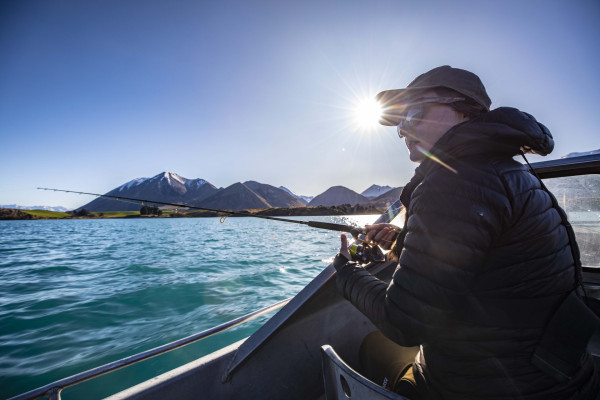
The Rakaia Lakes
Lake Coleridge: Lake Coleridge is the largest and most heavily fished lake in North Canterbury. It supports one of very few New Zealand populations of landlocked chinook salmon which are a common catch in the lake. The best access points to the lake are at the Intake (off Mt Algidus Rd), Ryton Bay (turn left off Harper Road just before the Ryton River bridge) and Harper Bay (continue up Harper Road after crossing the Ryton Bridge, through the Harper village and turn left after crossing the Harper River).
Lake Evelyn: This lake is accessed off Harper Road. Good shoreline fishing is available on the other side of the lake.
Lake Selfe: The shingle fan on the north western side of the lake is a popular spot for spin anglers.
Lake Henrietta: This lake does not receive a lot of angling pressure as it is mostly surrounded with swamp. However careful anglers can be rewarded with good fishing
Lakes Ida and Little Ida: These lakes are accessed by way of a walking track that starts at a car park between lakes Evelyn and Selfe. The walk takes approximately 30 minutes.
Lake Catherine (Monck): This is also accessed from the same walking track that is used to access Lake Ida. The track follows the Ryton River to the lake. Allow approximately one hour to reach the lake.
Lake Lilian: Lake Lilian is accessed through Glenthorne Station. Permission must be obtained from the station to use the road that runs up the Harper Valley from the top of Lake Coleridge. Once permission has been obtained, drive up the southern side of the river until reaching the Lilian Stream. Walk up the Lilian Stream for fifteen minutes to reach the lake.
Lake Georgina: A nice little lake that anglers can walk right around during a fishing session.
Lake Lyndon: This lake can be accessed from Lake Coleridge via the Lyndon (or dry weather) Road or directly off SH73 just over Porters Pass.
Lake Rubicon: This is a seldom visited lake lies in the foothills to the east of Porters Pass. Access is through Brooksdale Station, which can be accessed on SH73, a short distance east of Porters Pass. Permission should be obtained from the station in advance of a visit. The lake is a one hour walk from the homestead.
The Waimakariri Lakes
Lake Sarah: Travel approximately 2km past Lake Grasmere on SH73 and turn right onto Craigieburn Road. The lake is a five minute drive along this road.
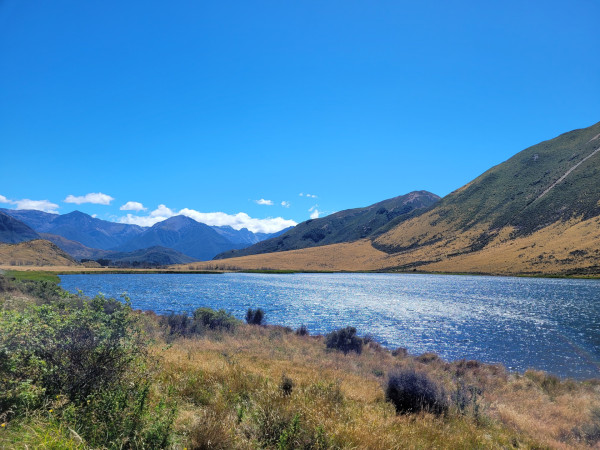
Lake Grasmere: Turn into a paddock marked with a F&G access sign about 3 kilometres west of Lake Pearson on SH73. Drive down the track and park at the lake edge.
Lake Pearson: A number of small tracks lead off SH73 to parking areas at the lake's edge. Lake Pearson is known for holding Mackinaw Fish (or Lake Trout). Mackinaw is a species that hasn't thrived well New Zealand other than here at Lake Pearson. They are still rare but do live alongside brown and rainbow trout. If you manage to catch a Mackinaw we would love images of the fish and the date and time you caught it for the national log.
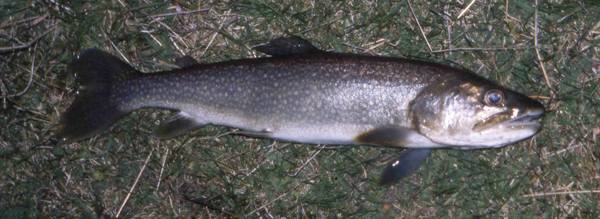
Lake Hawdon: Continue down Craigieburn Road beyond Lake Sarah. Just after crossing the railway line for the fourth time, a track can be seen on the right-hand side. Vehicle access is no longer permitted, and a fifteen-minute walk is required to reach the lake.
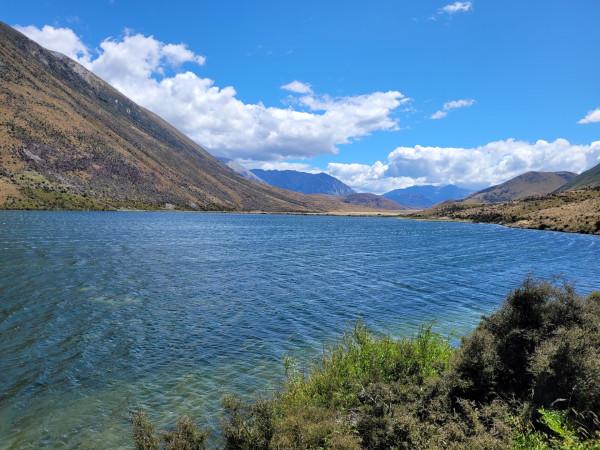
Lake Marymere: Continue Craigieburn Road past the Lake Hawdon track for 700m and another track will come into view on the right. Once again vehicle access is no longer permitted and a fifteen minute walk is required to reach the lake.
Lake Blackwater: This lake lies on Flockhill Station and is a one hour walk from Craigieburn Road. Anglers must obtain permission to use the track from the station.
Lake Letitia: Cross the Mt White Bridge over the Waimakariri River just past the Cass township, travel downstream on the shingle road for about an hour until reaching Mt White Station Homestead. The lake is at the end of the road just past the station cookshop. To fish this Lake you will need to obtain permission from Mt White Station.
The Hurunui Lakes
Lake Sumner: Unrestricted 4WD road access is available to Loch Katrine; from there, foot access is available to the head of Lake Sumner.
Loch Katrine: A settlement of huts at the head of Loch Katrine is the location for many holiday-makers using the area.
Lake Mason: Lake Mason and Little Lake Mason lie on Lake Taylor Station. Permission must be gained from the station before driving to the lake. Walking access is available to Lake Mason from Home Bay at Lake Sumner.
Lake Taylor: A popular fishing and camping spot

Lake Sheppard: Access to this lake is over private land through the Lakes Station homestead. Permission must be obtained from the Lakes Station before entering the property

Methods
Trolling, spinning and fly fishing are all popular methods in the high country lakes, although trolling and spinning are not permitted in every lake. Bait fishing is not permitted in any of the lakes. Trolling from a motorised boat is a popular technique in Lakes Coleridge and Sumner.
Lures such as Rapalas and Tasmanian Devils should be trolled at a slow walking pace around the drop-off zone, where the shallow margins drop away to the deeper water. Lures can either be trolled straight from the rod tip on a monofilament line or behind a downrigger or leadline, which will take them down deep.
Spin fishing from the shore is legal in most lakes and works best on a windy day when the fish are actively feeding. Stand at the downwind end of the lake and cast into the wind where the fish should be feeding on insects and fish being dislodged by the waves.
Lures such as Tasmanian Devils and Tobys work well in the smaller lakes, while ticers work better in the deeper lakes or in windy conditions where casting distance is important. Fly fishing is the most effective technique in calm conditions or for fish which are feeding predominantly on insects. In the early stages of the season, blind fishing with a dragonfly larvae imitation is effective.
Cast out into the deep water and retrieve the fly back up the ledge. As the season progresses anglers start to target fish feeding in the shallows. Cast a dry fly or nymph ahead of a cruising trout and give it a little twitch when the fish gets close.
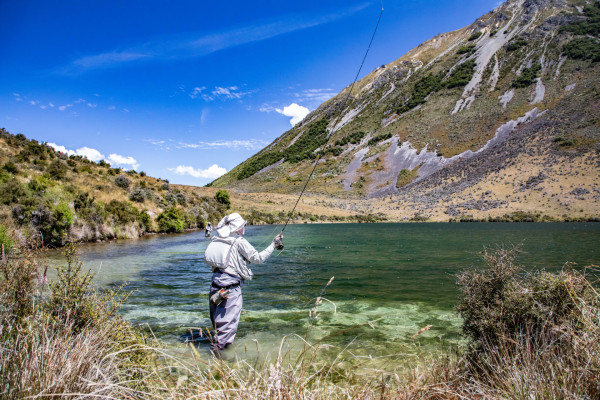
Regulations
A current sports fishing licence is required for trout and salmon fishing in the high country lakes. The authorised methods of fishing vary from lake to lake so please consult a current Regulation Guide before you commence fishing.
Further Information
The high country lakes lie at the foot of the Southern Alps and are subject to highly changeable weather patterns. Storms from the northwest and southwest can bring rain, snow and high winds at any time of year. In order to avoid disappointment and possible danger, anglers are strongly advised to check conditions before leaving home.